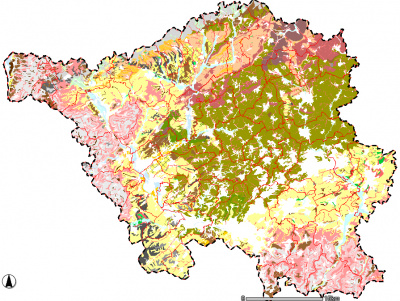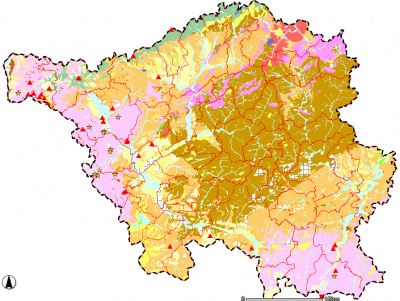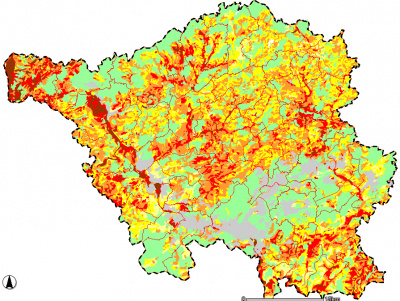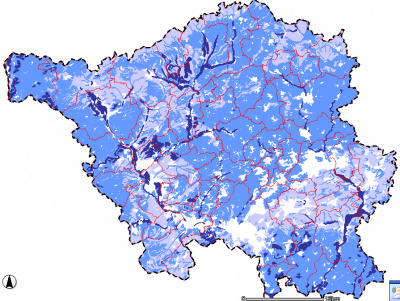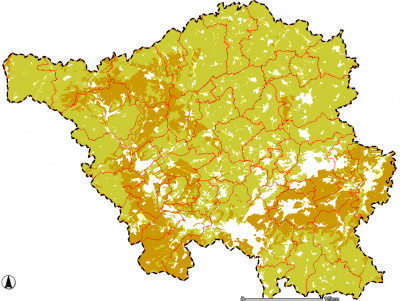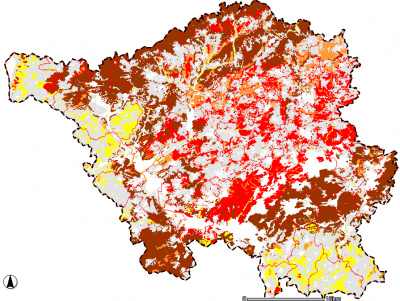Bodenschutz/en: Unterschied zwischen den Versionen
Tschug (Diskussion | Beiträge) |
Tschug (Diskussion | Beiträge) |
||
| (2 dazwischenliegende Versionen von 2 Benutzern werden nicht angezeigt) | |||
| Zeile 100: | Zeile 100: | ||
<p><strong>[//{{SERVERNAME}}/mapbender/frames/index.php?lang=de&gui_id=Geoportal-SL-2020&WMC=3031 Go to application: ‘Map of buffer areas for topsoils under forest management’]</strong></p> |
<p><strong>[//{{SERVERNAME}}/mapbender/frames/index.php?lang=de&gui_id=Geoportal-SL-2020&WMC=3031 Go to application: ‘Map of buffer areas for topsoils under forest management’]</strong></p> |
||
| + | == Contacts == |
||
| − | <div class="mw-translate-fuzzy"> |
||
| + | '''State Office for the Environment and Occupational Safety'''<br /> |
||
| − | ==Ansprechpartner== |
||
| + | Dept. 2.2 Soil Protection and Geology<br /> |
||
| − | '''Ministerium für Umwelt und Verbraucherschutz'''<br /> |
||
| − | Landesamt für Umwelt- und Arbeitsschutz "Schutzgebiete und Boden"<br /> |
||
Katja Drescher-Larres<br /> |
Katja Drescher-Larres<br /> |
||
| − | [mailto:k.drescher-larres@lua.saarland.de |
+ | [mailto:k.drescher-larres@lua.saarland.de Email]<br /> |
| − | + | Phone: +49 681 8500-1160<br /> |
|
| − | </div> |
||
Aktuelle Version vom 31. August 2022, 08:25 Uhr
Soil conservation

Soil performs a wide range of functions for the environment and human society. At the same time, soil is a fragile and non-reproducible resource that is exposed to many stresses from usage. As a basis for preventive soil conservation, land surveys conducted by soil scientists collect regionalised data about soil distribution, its state of health and need for protection, and hazards threatening soil in Saarland. The online map service from the State Office of the Environment and Occupational Safety currently offers eight applications for soils across Saarland.
Soil survey map
(shows soil distribution)
The soil survey map uses a 1:100,000 scale (BÜK 100) to offer a regionalised presentation of the soil science inventory. For reasons of scale and also because of the closely-spaced substrate transitions in Saarland, the extant soil units are typically characterised as ‘soil clusters’. A detailed guide provides explanations of the ecological properties of these soils.
Go to application: ‘Soil survey map (BÜK 100)’
Quaternary map
(offers insights into the most recent geological period in Saarland)
The quaternary period has left its mark in Saarland both in the form of independent substrates such as loess sections or river terrace deposits as well as periglacial processes of formation that have affected the uppermost layers of the pre-quaternary bedrock.
Go to application: ‘Quaternary map’
Map of nitrate retention capacity
(charts the storage capacity in the vadose zone for nitric nitrogen)
The nitrate retention capacity of soils in Saarland has been determined on the basis of the soil survey map and physical soil data from the Saarland Soil Information System (SAARBIS). The 1:100,000 scale survey map is used to identify soils that have a higher level of risk exposure for nitrate discharges into groundwater.
Go to application: ‘Nitrate retention capacity’
Map of natural yield potential
(offers information about soil fertility)
The presentation of the natural yield potential for agrarian soils addresses one of the usage functions defined in the German Federal Soil Protection Law (BBodSchG), section 2(2) and characterises the capacity of the soil to produce food as well as energy crops.
Go to application: ‘Natural yield potential’
Map of soil field capacity
(characterises soil water retention capacity)
The 1:100,000 scale survey map presents a core parameter as utilised in soil water management. The term ‘field capacity’ refers to the quantity of water that a soil in a natural state can retain after gravitational drainage and is a metric for soil water retention capacity. To ensure results are comparable, field capacity is evaluated up to a profile depth of 10 dm (FK10).
Go to application: ‘Soil field capacity’
Map of soil air capacity
(provides information about supply of oxygen to plant roots)
Air capacity is determined by measuring the proportion of macropores (coarse pores) in the soil pore space. Air capacity is a metric for the supply of oxygen to plant roots as well as soil aeration. To ensure results are comparable, air capacity is evaluated up to a profile depth of 10 dm (LK10).
Go to application: ‘Soil air capacity’
Map of location typing and soil potential for biotope development
(presents the soil’s characteristic biotope functions for vegetation)
Location typing for soils in Saarland is based on the soil units from the Saarland soil survey map (1:100,000 scale), which have been grouped into 11 location types featuring different moisture regimes and material inventories. Depending on water content and the supply of nutrients, the various location types offer high to very high potential for biotope development.
Go to application: ‘Map of location typing and soil potential for biotope development’
Map of buffer areas for topsoils under forest management
(shows a regionalised picture of soil acidification)
The 1:100,000 scale map shows the buffer areas for soils and therefore provides an indicator for the extent of soil acidification. The dataset represents analyses carried out until 1995: accordingly, acidic inputs spanning almost two decades are not accounted for. Recent data are available from studies conducted on specific territories and will be provided at a later date.
Go to application: ‘Map of buffer areas for topsoils under forest management’
Contacts
State Office for the Environment and Occupational Safety
Dept. 2.2 Soil Protection and Geology
Katja Drescher-Larres
Email
Phone: +49 681 8500-1160
